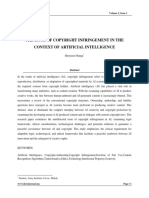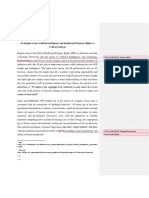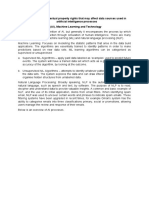0% found this document useful (0 votes)
26 views13 pagesFinal Dissertation Exam
This report analyzes the balance between innovation and intellectual property (IP) protection in the UK, particularly concerning artificial intelligence (AI). It highlights the challenges posed by existing copyright and patent laws in defining authorship and ownership of AI-generated works, emphasizing the need for legal reform to accommodate advancements in AI technology. The document also discusses the implications of recent legal cases and proposes changes to enhance the UK's IP framework post-Brexit, aiming to foster both creativity and innovation.
Uploaded by
dirtygbandeCopyright
© © All Rights Reserved
We take content rights seriously. If you suspect this is your content, claim it here.
Available Formats
Download as DOCX, PDF, TXT or read online on Scribd
0% found this document useful (0 votes)
26 views13 pagesFinal Dissertation Exam
This report analyzes the balance between innovation and intellectual property (IP) protection in the UK, particularly concerning artificial intelligence (AI). It highlights the challenges posed by existing copyright and patent laws in defining authorship and ownership of AI-generated works, emphasizing the need for legal reform to accommodate advancements in AI technology. The document also discusses the implications of recent legal cases and proposes changes to enhance the UK's IP framework post-Brexit, aiming to foster both creativity and innovation.
Uploaded by
dirtygbandeCopyright
© © All Rights Reserved
We take content rights seriously. If you suspect this is your content, claim it here.
Available Formats
Download as DOCX, PDF, TXT or read online on Scribd
/ 13























































































